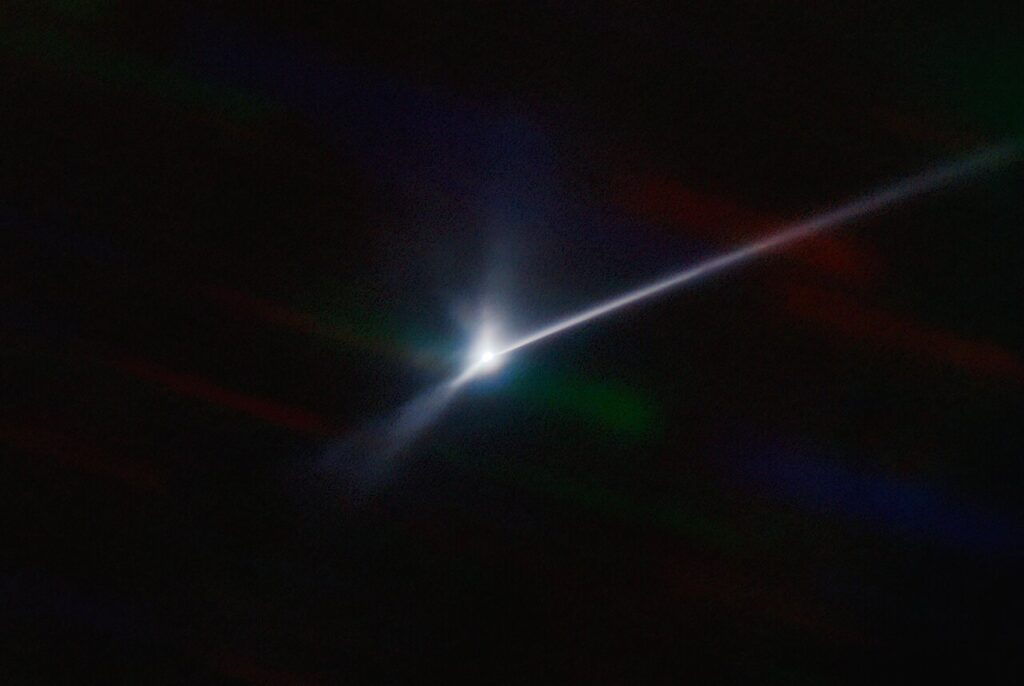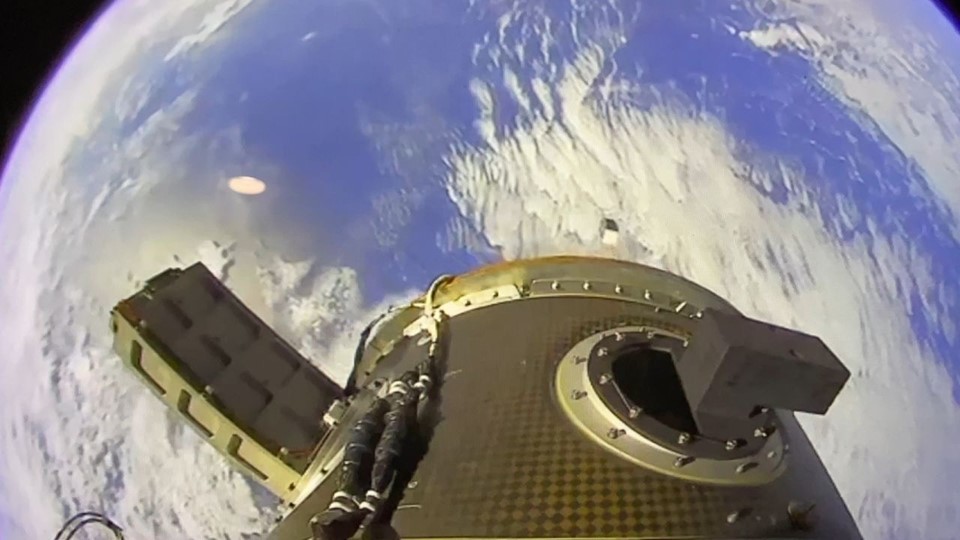Early Saturday morning, another company entered the exclusive club of successful orbital launchers, Firefly Aerospace, when their second attempt to reach orbit, named To The Black, lifted off on October 1. Plus, a crater in Spain, a new DART image, Juno flies by Europa, and an interview with Jochen Grandell regarding the Meteosat program.
Podcast
Show Notes
Ancient impact crater discovered in Spain
- EPS press release
Dimporphos sprouts a comet-like tail after impact
- NOIRLab press release
Juno makes close flyby of Jupiter’s moon, Europa
- NASA JPL press release
Lonely galaxy gives universe its size
- NASA image release
Firefly makes orbit on second try
- Firefly press release
ISRO’s Mars Orbiter Mission has come to an end
Transcript
You’ve often heard us say that science progresses one image and one technological advance at a time. The catch is, people need to notice the image and use the technology. Today, we revisit one of the more important-to-science images that the Hubble Space Telescope initially released back in December during the holidays and highlighted again on September 30, when hopefully more people will see it.
We also look at the spacecraft that sometimes get us that data. Join us as we bid adieu to the Mars Orbiter Mission and say hello to Firefly with their latest successful launch and deployment.
We also have updates on the DART mission, Juno’s latest picture of Europa, and an interview with Jochen Grandell of Eumetsat about the Meteosat missions.
All this and more is coming at you right here on the Daily Space.
I am your host, Dr. Pamela Gay, and we are here to put science in your brain.
Last week, we shared a story about how a two-billion-year-old South African crater is more extensive than originally thought with a much larger impactor than originally calculated. We mentioned how difficult it is to measure ancient craters because of all that erosion does to hide the evidence. It’s also difficult to just find impact craters; however, at the Europlanet Science Congress last week, researchers shared their evidence for the discovery of a probable impact crater in Spain.

This crater, estimated at four kilometers in diameter, would be the first discovered in the Iberian peninsula and is the result of over fifteen years of research. Presenter Juan Antonio Sánchez Garrido explains: We believe that the impact event occurred around 8 million years ago. We have investigated numerous aspects of the geology, mineralogy, geochemistry, and geomorphology of the region. The basins of Alhabia and Tabernas in the area are filled with sediments dating back between 5 and 23 million years, and they overlie older metamorphic rocks. Much of the impact structure is buried by more modern sediments, but erosion has exposed it and opened up the opportunity for studies.
One piece of evidence for the crater is the presence of ‘shocked’ quartz crystals in the sedimentary rocks of the area. Shocked quartz occurs under immense pressure, usually due to an impact event.
We look forward to hearing more about this newly discovered impact crater.

Speaking of impacts and craters, we have another fantastic image of the after-effects of the DART spacecraft’s crash into the moonlet asteroid Dimorphos. Today’s selection was taken by the SOAR Telescope in Chile two days after the impact event and reveals a significant trail of debris reflecting in the sunlight.
The dust trail is similar in appearance to a comet’s tail; a tail that extends out from the asteroid by at least 10,000 kilometers. Once the debris trail and Dimporphos are studied, we should be able to learn just how much material was ejected and at what speed. And we should be able to determine the distribution of particle sizes in the dust cloud. Astronomer Matthew Knight notes: Now begins the next phase of work for the DART team as they analyze their data, and observations by our team and other observers around the world who shared in studying this exciting event.
We’ll bring all the latest on the DART mission and asteroid Dimorphos as the information is released.
From craters and planetary defense, let’s now turn to the search for life beyond Earth but within our solar system.
One of the prime candidates for that search is Jupiter’s moon Europa, a world slightly smaller than the Earth’s Moon and the sixth-largest moon in our solar system. Beneath the thick, icy shell lies a salty subsurface ocean which researchers have shown to be capable of sustaining life. And right now, a new science team is preparing for the future Europa Clipper mission to the Jovian moon. Planned to launch in 2024, the mission’s main science goal is to truly determine if the oceans could support life.

In preparation for that mission and as a part of the extended mission of NASA’s Juno spacecraft, on September 29, the JunoCam onboard Juno took pictures of Europa during a very close flyby of the icy world. The window for data collection was a mere two hours, and the craft was flying by at 23.6 kilometers per second. The images collected were of a region just to the north of Europa’s equator, and community scientists have processed them to reveal rugged terrain features including ridges and troughs. We’ll have links to some of the images in our show notes at DailySpace.org.
Taken from a mere 352 kilometers, this flyby was the third closest pass in history and the most recent since the Galileo mission back in 2000. As a result of the close pass and newer camera, the images collected had a resolution of 1 kilometer per pixel. Co-investigator Candy Hansen explains: The science team will be comparing the full set of images obtained by Juno with images from previous missions, looking to see if Europa’s surface features have changed over the past two decades. The JunoCam images will fill in the current geologic map, replacing existing low-resolution coverage of the area.
But remember, JunoCam was an afterthought to the Juno spacecraft – an outreach project to inspire people to participate in science by processing the images. On top of the pictures, Juno’s other instruments collected data on the structure of the ice shell, the surface composition, the ionosphere, and even Europa’s interactions with Jupiter’s massive magnetosphere.
Coming up, a look at a lonely galaxy, a launch, and the end of a mission.

Sometimes NASA Hubble puts out an image release about an image that has already been out for a while but may not have gotten the attention its science deserved.
On September 30, NASA directed our attention at a lonely spiral galaxy cataloged as UGC 9391. Most recently released in December 2021, this system has been under regular surveillance by the Hubble Space Telescope since 2003 when supernova 2003du was spotted in its disk.
Located just 130 million light-years away, this system is one of the few where researchers have been able to observe both a type 1a supernova and the presence of cepheid variable stars. This convergence of objects allows researchers to work on calibrating these two different ways of measuring distance.
We’ve known for around a century that cepheid variable stars vary in direct relation to their luminosity. This means that if we look at how bright a Cepheid appears on average, and we measure how fast it changes in brightness, we can calculate its distance. These distances have been calibrated using parallax measurements to the nearest cepheids in our galaxy. Type 1a supernovae also vary, admittedly just once in a known way, and also have a consistent luminosity. No type 1a supernovae have been found in our galaxy, so we have to use cepheids in other galaxies to calibrate type 1a distances.
And UGC 9391 is one of those few galaxies.
And here it is shining without any apparent nearby companions, allowing us to calibrate our measurements to galaxies that only contain supernovae.
Coming up next, we go to Erik Madaus for rocket news, both good and sad.

Early Saturday morning, another company entered the exclusive club of successful orbital launchers, Firefly Aerospace. Their second attempt to reach orbit, named To The Black, lifted off at 07:01 UTC on October 1. The rocket’s four Reaver engines ignited, and the vehicle headed south into an unusual highly retrograde polar orbit. Just under eight minutes later, it was in orbit.
This made it only the second carbon composite structure rocket to reach orbit after the Rocket Lab Electron, and the first rocket to do so with a combustion tap-off cycle engine. This cycle takes some hot gas from the combustion chamber and redirects it back into the turbopumps to power them, instead of using a separate gas generator. The combustion tap-off cycle is simpler to make and in operation, but harder to start up and rougher on the engine because of higher temperatures. Blue Origin has previously flown a tap-off engine, the BE-3, on its suborbital New Shepard engine.
An hour later after another burn of the second stage engine, the payloads deployed. This engine restart was considered a stretch goal for the demo mission.
It took some time to confirm these two events as the second stage missed its first ground station pass over Hawaii, finally phoning home over South Africa and again in California. Teams later identified that the issue in Hawaii was with the ground station itself, not the rocket. This isn’t unexpected for an inaugural launch as teams work out issues between the rocket and all of its global infrastructure.

Wait a moment. Firefly? Reaver? To the Black? This company is full of sci-fi nerds. Gotta love it.
Because this was a test flight, the vehicle only carried three payloads totaling 35 kilograms of the 1,000-kilogram payload the rocket is designed for. It’s common to put real but low-value slash-risk payloads on launches of new rockets. Either that or large blocks of metal. Remember the Tesla SpaceX launched on the first Falcon Heavy? That was also a demonstration payload. Rocket companies may offer a very reduced or even free ride to orbit, with the understanding that the payloads may not make it to orbit.
One of the successfully launched payloads was Teachers in Space’s Serenity II. The first Serenity was on the first Alpha, which failed to reach orbit. Another payload, a PocketQube deployer, also flew on the first Alpha flight with a second one built for flight two. PocketQube’s are like CubeSats but even smaller – only five centimeters on a side. Six PocketQubes were deployed on today’s flight.
To The Black was originally scheduled to launch earlier in September but was delayed after two aborted attempts and a further delay after a typhoon traveled up the west coast of the US.
Alpha’s next mission will be for NASA, launching the ELaNa 43 mission.

We also have some sad news. This weekend the Indian Space Research Organization (ISRO) announced that they had lost contact with the Mars Orbiter Mission (MOM) spacecraft, which had been orbiting the red planet since September 2014, lasting a whole eight years longer than its six-month mission.
As of press time, ISRO had not confirmed the precise reason that the spacecraft failed, but they will do so soon. One possible reason is that they lost contact with Earth while MOM was eclipsed by Mars. The spacecraft has eclipses from August to September every year, once every orbit and lasting an hour. MOM was designed to manage this by itself but may have run out of fuel or accidentally pointed its antenna away from Earth during an automated recovery maneuver after an eclipse ended.
The spacecraft achieved a lot during its mission, including discovering energetic argon in the diffuse atmosphere of Mars and that there is more oxygen than carbon dioxide in the atmospheric region between 260 and 280 kilometers.
MOM was an incredible mission. The program’s budget was 4.5 million Indian Rupees, equivalent to just under 9 million U.S. Dollars in 2022, and an absolute bargain for what they achieved, considering their goal was to just enter Mars orbit.
This is not the end of ISRO’s Mars ambitions, though, because the Mars Orbiter Mission 2 will launch No Earlier Than 2024.
And now, let’s go to our pre-recorded interview with Beth Johnson and Jochen Grandell from Eumetsat.
Interview
The first Meteosat was launched 45 years ago on November 23, 1977, beginning a program that has provided geostationary meteorological satellites ever since. Joining us today is Jochen Grandell, Program Scientist for the Meteosat third generation, to talk about this continuing project and its crucial weather data collection.
Thank you for joining us today, Jochen, and welcome.
[Interview continues.]
Once again, thank you for taking the time to speak with us. Good luck with the launch later this year.
To all of you watching, our prerecorded interview ran longer than we can air here on NowMedia. You can catch the conversation in its entirety on our website, DailySpace.org.
While you’re there, check out our show notes to find more information on all our stories, including images. As always, we’re here thanks to the donations of people like you. If you like our content, please consider joining our Patreon at Patreon.com/CosmoQuestX.
Credits
Written by Pamela Gay, Annie Wilson, Beth Johnson, Erik Madaus, and Gordon Dewis
Hosted by Pamela Gay, Beth Johnson, and Erik Madaus
Audio and Video Editing by Ally Pelphrey
Content Editing by Beth Johnson
Intro and Outro music by Kevin MacLeod, https://incompetech.com/music/


 We record most shows live, on Twitch. Follow us today to get alerts when we go live.
We record most shows live, on Twitch. Follow us today to get alerts when we go live.